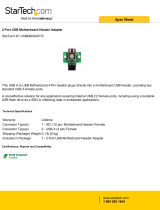
MegaRAC® G4 User’s Guide
iv
Sensor Reading......................................................................................................................... 22
Event Log................................................................................................................................... 23
Configuration Group................................................................................................................... 23
Network Settings........................................................................................................................ 23
User List..................................................................................................................................... 24
Add New User ........................................................................................................................ 25
Modify User ............................................................................................................................ 26
Delete User............................................................................................................................. 26
Alert List..................................................................................................................................... 27
Alert - Modify Alert.................................................................................................................. 27
Send Test Alert....................................................................................................................... 27
Mouse Mode Settings................................................................................................................ 28
SSL Configuration...................................................................................................................... 28
LDAP Settings............................................................................................................................ 29
Remote Control Group............................................................................................................... 30
Launch Redirection.................................................................................................................... 30
Remote Console Shortcut Key Combinations ........................................................................... 30
Console Redirection Window..................................................................................................... 31
Video ...................................................................................................................................... 31
Keyboard................................................................................................................................ 31
Mouse..................................................................................................................................... 32
Options................................................................................................................................... 32
Device..................................................................................................................................... 33
Help........................................................................................................................................ 33
Power Status and Control.......................................................................................................... 33
Maintenance Group ................................................................................................................... 33
Firmware Update ....................................................................................................................... 34
Logging Out................................................................................................................................ 34
Appendix A Troubleshooting................................................................................................ 35
BMC Not Responding................................................................................................................ 35
Problem.................................................................................................................................. 35
Symptom ................................................................................................................................ 35
Solution................................................................................................................................... 35
Cannot Power On the Host System Remotely........................................................................... 36
Problem.................................................................................................................................. 36
Symptom ................................................................................................................................ 36
Solution................................................................................................................................... 36
Appendix B Serial Over LAN................................................................................................. 37
Hardware Setup......................................................................................................................... 37
BIOS....................................................................................................................................... 37
Connecting using Hyper Terminal.............................................................................................. 37
Appendix C G4ConfigApp ..................................................................................................... 39
Overview.................................................................................................................................... 39
Getting Started........................................................................................................................... 39
Network Configuration Tab........................................................................................................ 39
User Manager Tab..................................................................................................................... 40
Adding a User......................................................................................................................... 40
User Properties ...................................................................................................................... 40
Appendix D SMASH Command Line Utility ......................................................................... 41
Overview.................................................................................................................................... 41
Prerequisites........................................................................................................................... 41
Hardware Setup......................................................................................................................... 41

























